Abstract
Plasma advanced oxidation protein products (AOPP) are a biomarker for increased production of reactive oxygen species. We examined the possible association between pain to hospital time, plasma AOPP, and outcome of patients receiving percutaneous coronary intervention (PCI) for ST-elevation acute myocardial infarction (STEMI). Plasma AOPP was determined at hospitalization as well as 24 and 48 h after PCI in 79 patients with suspected STEMI. Patients were stratified into a control group (Group I, n = 21) after exclusion of coronary artery disease, Group II (n = 46) with pain to hospital time <12 h, and Group III (n = 33) with pain to hospital time >12 h. Associations between pain to hospital time and AOPP as well as incidence of major adverse cardiac events (MACE) during 6 months of follow-up were analyzed. Plasma AOPP at admission was significantly higher in patients of Group II (97.58 ± 23.41 μmol/l) and Group III (184.52 ± 30.41 μmol/l) in comparison with Group I (57.41 ± 13.60 μmol/l, all P < 0.001). Plasma AOPP concentration was positively correlated with pain to hospital time and associated with an increased incidence of MACE during the 6-month follow-up period. Prolonged ischemia is associated with increased oxidative stress and poor prognosis in patients treated with PCI for STEMI.
Similar content being viewed by others
References
Cai H, Harrison DG (2000) Endothelial dysfunction in cardiovascular diseases: the role of oxidant stress. Circ Res 87(10):840–844
Shen CX, Chen HZ, Ge JB (2004) The role of inflammatory stress in acute coronary syndrome. Chin Med J (Engl) 117: 133–139
Witko-Sarsat V, Friedlander M, Capeillère-Blandin C, Nguyen-Khoa T, Nguyen AT, Zingraff J, Jungers P, Descamps-Latscha B (1996) Advanced oxidation protein products as a novel marker of oxidative stress in uremia. Kidney Int 449:1304–1313
Tovbin D, Mazor D, Vorobiov M, Chaimovitz C, Meyerstein N (2002) Induction of protein oxidation by intravenous iron in hemodialysis patients: role of inflammation. Am J Kidney Dis 40:1005–1012
Descamps-Latscha B, Witko-Sarsat V, Nguyen-Khoa T, Nguyen AT, Gausson V, Mothu N, London GM, Jungers P (2005) Advanced oxidation protein products as risk factors for atherosclerotic cardiovascular events in nondiabetic predialysis patients. Am J Kidney Dis 45:39–47
Drüeke T, Witko-Sarsat V, Massy Z, Descamps-Latscha B, Guerin AP, Marchais SJ, V Gausson, Gérard M. London GM (2002) Iron therapy, advanced oxidation protein products, and carotid artery intima-media thickness in end-stage renal disease. Circulation 106:2212–2217
Kaneda H, Taguchi J, Ogasawara K (2002) Increased level of advanced oxidation protein products in patients with coronary artery disease. Atherosclerosis 162:221–225
Skvarilova, M., Bulava A, Stejskal D, Adamovská S, Bartek J (2005) Increased level of advanced oxidation products (AOPP) as a marker of oxidative stress in patients with acute coronary syndrome. Biomed Pap Med Fac Univ Palacky Olomouc Czech Repub 149:83–87
Oka H, Ikeda S, Koga S, Miyahara Y Kohno S (2008) Atorvastatin induces associated reductions in platelet P-selectin, oxidized low-density lipoprotein, and interleukin-6 in patients with coronary artery diseases. Heart Vessels 23:249–256
Kubota N, Kasai T, Miyauchi K, Njaman W, Kajimoto K, Akimoto Y, Takahiko Kojima, Yokoyama K, Kurata T, Daida H (2008) Therapy with statins and aspirin enhances long-term outcome of percutaneous coronary intervention. Heart Vessels 23:35–39
Tsutsui H (2001) Oxidative stress in heart failure: the role of mitochondria. Intern Med 40:1177–1182
Crisby M, Kublickiene K, Henareh L, Agewall S (2009) Circulating levels of autoantibodies to oxidized low-density lipoprotein and C-reactive protein levels correlate with endothelial function in resistance arteries in men with coronary heart disease. Heart Vessels 24:90–95
Ferrari R, Pepi P, Ferrari F, Nesta F, Benigno M, Visioli O (2001) Metabolic derangement in ischemic heart disease and its therapeutic control. Am J Cardiol 82(5A):2K–13K
Gambert S, Vergely C, Filomenko R, Moreau D, Bettaieb A, Opie LH, Rochette L (2006) Adverse effects of free fatty acid associated with increased oxidative stress in postischemic isolated rat hearts. Mol Cell Biochem 283(1–2):147–152
Author information
Authors and Affiliations
Corresponding author
Additional information
These authors contributed equally to this article.
Rights and permissions
About this article
Cite this article
Feng, Y., Shen, C., Ma, G. et al. Prolonged pain to hospital time is associated with increased plasma advanced oxidation protein products and poor prognosis in patients with percutaneous coronary intervention for ST-elevation myocardial infarction. Heart Vessels 25, 374–378 (2010). https://doi.org/10.1007/s00380-009-1220-8
Received:
Accepted:
Published:
Issue Date:
DOI: https://doi.org/10.1007/s00380-009-1220-8




